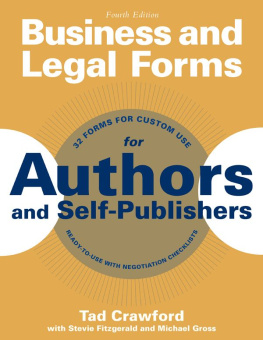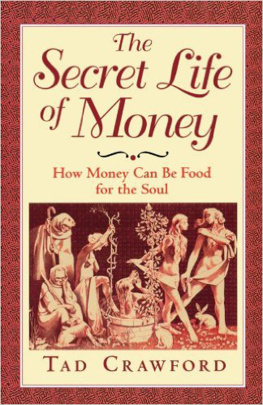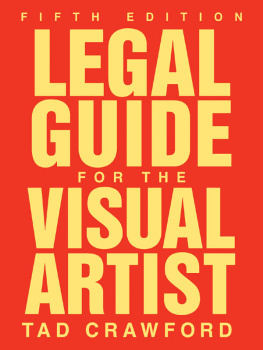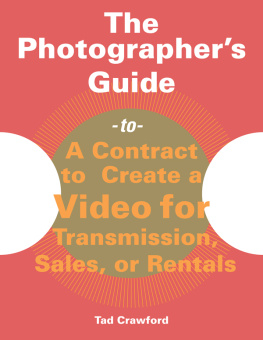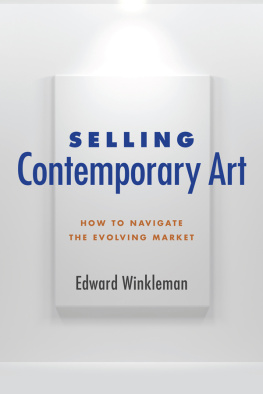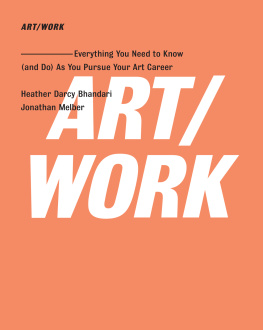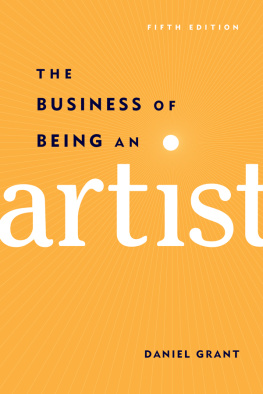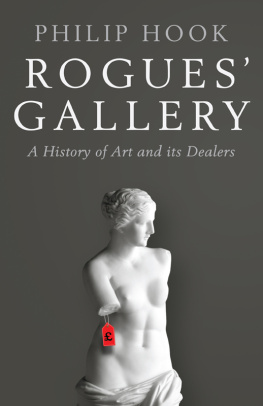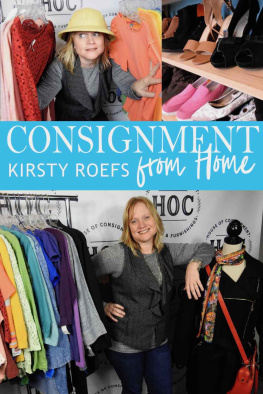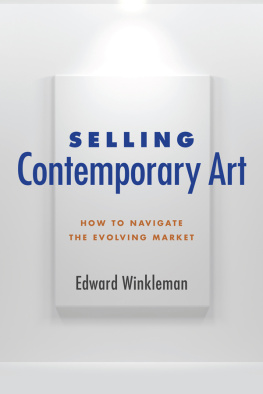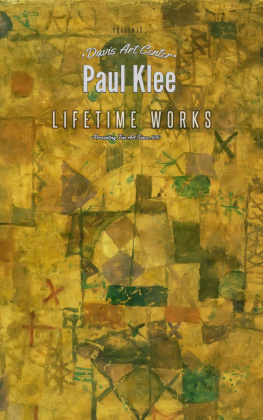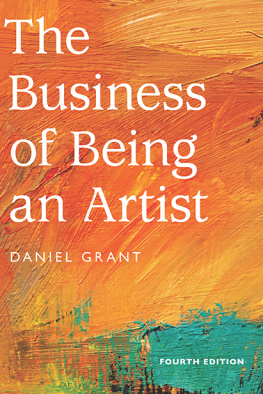THE
ARTIST-GALLERY
PARTNERSHIP
A Practical Guide to Consigning Art
THIRD EDITION

Tad Crawford and Susan Mellon
INTRODUCTION BY
Daniel Grant

1981, 1998, 2008 Tad Crawford and Susan Mellon
All rights reserved. Copyright under Berne Copyright Convention, Universal Copyright
Convention, and Pan-American Copyright Convention. No part of this book may
be reproduced, stored in a retrieval system, or transmitted in any form, or by any
means, electronic, mechanical, photocopying, recording, or otherwise, without prior
permission of the publisher.
Published by Allworth Press
An imprint of Allworth Communications
10 East 23rd Street, New York NY 10010
Cover design by Derek Bacchus
Book design/typography by Sharp Des!gns, Inc., Lansing, MI
ISBN-10: 1-58115-645-6
ISBN-13: 978-1-58115-645-4
eBook ISBN: 978-1-58115-750-5
Library of Congress Catalog Card Number: 98-70405
This book is designed to provide accurate and authoritative information with respect
to the subject matter covered. It is sold with the understanding that the publisher
is not engaged in rendering legal, accounting, or other professional services. If legal
advice or other expert assistance is required, the services of a competent attorney
or professional person should be sought. While every attempt is made to provide
accurate information, the author and publisher cannot be held accountable for any
errors or omissions.
Acknowledgments
F or help with the first edition of this book the authors acknowledge with gratitude the invaluable assistance of Robert Anestis and Elena Canavier, the generous support of the National Endowment for the Arts, and the outreach efforts of The American Council for the Arts which published that edition. For help with this second edition, thanks are due to the staff at Allworth PressRobert Porter, Ted Gachot, and especially Anne Hellman, who guided this expanded edition through the editorial process, and Nyier Abdou, who scrupulously reviewed and corrected the final draft. We are also appreciative for the assistance of Adria G. Kaplan of the Columbia Law School Center for Law and the Arts in locating appropriate research assistance and for the thorough research and contributions made by Laura Stevens. The third edition also benefitted from the efforts of the staff at Allworth Press, including Robert Porter and Kate Ellison, and research by Carrie Ligozio to update the contents of the book.
Contents
Introduction
by Daniel Grant
T he arts world is increasingly described as a business, so why do so many artists and dealers refer to their relationships as a marriage? Similar to romantic link-ups, artists and dealers often claim to have met through mutual acquaintances; both talk of hand-holding, being listened to, or taken care of; they invite each other for dinners, parties, even vacations; and their breakups are likened to divorce. Supporting the entire affair is the sale of artworks. The art market is an odd mix of money and affection.
Relationships are what bring artists and dealers together, and these relationships (artist-collector or dealer-collector) help to sell works of art. Some artists try to avoid the business of making individual connections with people by blindly sending slides of their work to galleries around the country or through setting up a Web site for their work. Undoubtedly, there are success stories to be found through these methods. However, almost all artists discover that they need to establish a personal relationship with a dealer or collector (or both) in order to achieve artistic recognition and financial success.
Business and personal elements of the artist-dealer relationship are frequently entwined. Rhona Hoffman, an art dealer in Chicago, noted that conversations with artists she represents may start out strictly business but switch to personal thingsrestaurants, movies, familiesthen back to business. It doesnt have to be clear what kind of relationship you are specifically pursuing.
Artists and dealers often have both personal and professional relationships, but when dealing with the business end of things, both sides do need to be clear as to the nature of their interactions. How often and in what context will the artists work be displayed? What sales commission will be paid to the dealer? How soon will an artist be paid following a sale? Who pays for framing, shipping, advertising, insurance, catalogues? Is the dealer an exclusive agent for the artist? How long will this agreement be in effect? Tacit understandings and handshakes must give way to sometimes lengthy conversations and even legal contracts that detail how artist and dealer will work with one another. The Artist-Gallery Partnership: A Practical Guide to Consignment offers ground rules for these conversations, supplying applicable laws and legal concepts, as well as ideas for resolving disputes and changing the terms of an agreement. The Standard Agreement is a highly flexible document that encourages dialogue and should not frighten away those who are honest and well-intentioned.
When Jackson Pollock signed his first contract with collector and dealer Peggy Guggenheim in 1943, he was able to quit his job decorating ties to concentrate on painting. That first contract paid him a stipend of $150 per month, with guaranteed sales of $2,700 annually (if there were less than $2,700 in sales, Guggenheim would be paid the difference in paintings). His second contract with her two years later raised the stipend to $300 per month and gave Guggenheim ownership of Pollocks entire artistic output for the year with the exception of one painting that the artist could retain. The terms of those contracts might not satisfy artists nowadays, but it was beneficial to both Pollock and Guggenheim then, reflecting her trust in his talents and allowing him to work unencumbered by financial constraints. This was a true partnership.
Back in 1981 when The Artist-Gallery Partnership was first published, few artists and dealers used written agreements. A growing number of artists have insisted on them since then, sometimes to the chagrin of their galleries. In my experience, a conversation followed by a handshake tends to work just as well as a legal contract, said New York dealer Nancy Hoffman, who lets the artist decide whether or not to create a written consignment agreement. If an artist Im interested in wants a contract, well have a contract.
GETTING TO KNOW YOU
An artist-dealer relationship is frequently the outgrowth of other relationships, for instance, between a dealer and other artists he or she represents. The artists whose work Im most interested in seeing are those who are recommended by other artists I know and respect, said New York dealer Curt Marcus. Frequently, an artist in a gallery opens the door for other artists to be represented by the same dealer in this way. Hugh Kepets and Harriet Shorr, represented at New Yorks Fischbach Gallery, both spoke on my behalf, said Nancy Hagin, crediting her two friends with gaining her a dealer. In the who-knows-whom world of art, introductions matter.
The artists recommendation does not ensure that the person he or she is promoting will be taken on by the dealer, but it does increase the likelihood that the persons work will be given a serious look. Still, the new artists work must be suitable to the gallery, and a personal relationship needs to emerge between the artist and the dealer. Hagin said that an artist-friend at another gallery had written a letter of introduction for me, but my meeting with the dealer there turned out to be a disaster. We didnt get along; he didnt really like my work. It was an embarrassment not only for me but for the artist who had written the letter. One notable instance of an artist throwing his weight around involved sculptor William King who left dealer Virginia Zabriskie after she refused to give his then-girlfriend a show. He joined the gallery of dealer Terry Dintenfass, who agreed to show the girlfriends work; King later regretted his actions. Virginia told me at the time, Youre one dumb cookie, and she was right, he said.


